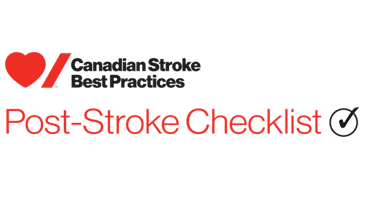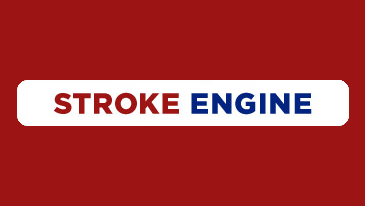- Definition and Considerations
- 1. Initial Stroke Rehabilitation Assessment
- 2. Stroke Rehabilitation Unit Care
- 3. Delivery of Inpatient Stroke Rehabilitation
- 4. Outpatient and In-Home Stroke Rehabilitation (including Early Supported Discharge)
- 5.1 Management of the Upper Extremity Following Stroke
- 5.2. Range of Motion and Spasticity in the Shoulder, Arm and Hand
- 5.3. Management of Shoulder Pain & Complex Regional Pain Syndrome (CRPS) following Stroke
- 6.1. Balance and Mobility
- 6.2. Lower Limb Spasticity following Stroke
- 6.3. Falls Prevention and Management
- 7. Assessment and Management of Dysphagia and Malnutrition following Stroke
- 8. Rehabilitation of Visual and Perceptual Deficits
- 9. Management of Central Pain
- 10. Rehabilitation to Improve Language and Communication
- 11. Virtual Stroke Rehabilitation
4. Outpatient and In-Home Stroke Rehabilitation (including Early Supported Discharge)
6th Edition - 2019 UPDATED
4.1 Outpatient & In-Home Rehabilitation
- Following stroke, people with ongoing rehabilitation goals should continue to have access to specialized stroke services after leaving hospital [Evidence Level A].
- This should include facility-based outpatient services and/or in-home rehabilitation services [Evidence Level A].
- Outpatient and/or in-home rehabilitation services should be provided by specialized interdisciplinary team members as appropriate to patient needs and in consultation with the patient and family [Evidence Level C].
- Services should ideally begin within 48 hours of discharge from an acute hospital or within 72 hours of discharge from inpatient rehabilitation [Evidence Level C].
- The choice of setting for outpatient and/or in-home rehabilitation service delivery should be based on patient functional rehabilitation needs, participation-related goals, availability of family/social support, patient and family preferences [Evidence Level C].
- Patients and families should be involved in their management, goal setting, and transition planning [Evidence Level A].
- Outpatient and/or in-home rehabilitation services should include the same elements as coordinated inpatient rehabilitation services [Evidence Level B], and include:
- An interdisciplinary stroke rehabilitation team [Evidence Level A].
- A case coordination approach including regular team communication to discuss assessment of new clients, review client management, goals, and plans for discharge or transition [Evidence Level B].
- Therapy provided for a minimum of 45 minutes per day [Evidence Level B] per required discipline, 2 to 5 days per week, based on individual patient needs and goals [Evidence Level A]; ideally for at least 8 weeks [Evidence Level C].
- Interprofessional care planning and communication is essential to ensure continuity of care, patient safety, and to reduce risk of complications and adverse events during stroke care particularly at transition points. [Evidence Level C]. Refer to Transitions and Community Participation Module, Section 3 for more information.
- At any point in their recovery, people with stroke who have experienced a change in functional status and who would benefit from additional rehabilitation services should be offered a further period of outpatient rehabilitation if they meet the requirements outlined in Box One: Eligibility and Criteria for Stroke Rehabilitation [Evidence Level B].
4.2 Early Supported Discharge (ESD)
- Early supported discharge services, designed to reduce length of hospital stay and still provide same intensity of inpatient rehabilitation, are an acceptable form of rehabilitation and should be offered to a select group of patients when available and provided by a well-resourced, coordinated specialized team [Evidence Level A].
- Criteria for ESD candidacy include:
- Mild to moderate disability [Evidence Level A];
- Ability to participate in rehabilitation from the point of discharge [Evidence Level A];
- Medically stable, availability of appropriate nursing care, necessary resources and support services (e.g., family, caregivers, and home care services) [Evidence Level A].
- ESD services should be provided within 48 hours of discharge from an acute hospital or within 72 hours of discharge from inpatient rehabilitation [Evidence Level C].
- Services should be provided five days per week at the same level of intensity as they would have received in the inpatient setting to meet patient needs [Evidence Level B]. Refer to Section 3 for more information.
- Where possible, it should be provided by the same team that provided inpatient rehabilitation to ensure smooth transition [Evidence Level A]
- Where different therapists are providing the home-based rehabilitation, close communication with the hospital-based rehabilitation team is important during the transition and processes to facilitate communication should be implemented [Evidence Level C].
Some patients with mild impairments can be safely transferred back to their homes to continue their rehabilitation and achieve outcomes that are as good as or better than those that would have been attained had they remained in hospital. This form of service provision, known as early-supported discharge (ESD) may be desirable where resources exist and may have the added benefit of being less costly.
Many patients who have completed a course of inpatient rehabilitation will still require ongoing therapy provided in the community to achieve their desired goals once discharged from hospital. Community-based rehabilitation may be defined as care received once the patient has passed the acute stage and has transitioned back to their home and community environment. In smaller communities and rural and remote settings, access to outpatient and/or community rehabilitation presents a significant challenge, and as such, innovative measures such as in-home therapy and telemedicine technology should be utilized.
The evidence suggests that community reintegration and participation takes up to one-year or more post-stroke and individuals make the most gains within the first 6 months post-stroke.
When physical limitations are minor, people with stroke emphasize the need to still receive psychological support and care. In addition, people with stroke state that education is required to ensure expectations for recovery are understood and that the steps for how to re-access rehabilitation services are clear. A stroke navigator or similar role has been recognized as an effective model during this stage to help link people with stroke to the appropriate local services or telehealth services, including accessing transportation assistance if required. Furthermore, post discharge from inpatient rehabilitation, people with stroke emphasized the importance of education relating to available support groups, including local groups and groups via telehealth or social media.
There is a marked lack of available outpatient and community-based rehabilitation resources. Therefore, the health system should aim to provide the following:
- Timely access to stroke rehabilitation services in the community following discharge.
- Organized and accessible stroke care in communities, including for patients with communication challenges.
- Increased numbers of skilled clinicians who have experience practicing in outpatient and community rehabilitation.
- Optimization of strategies to prevent the recurrence of stroke, including regular screening for stroke risk factors and use of standardized screening tools.
- Stroke rehabilitation support for caregivers to increase patient/caregiver understanding of rehabilitation plans and improve adherence.
- Long-term rehabilitation services widely available, and without financial barriers, in nursing and continuing care facilities, and in outpatient and community programs, including in-home visits.
- Increased use of telemedicine technologies to broaden access to outpatient rehabilitation services.
- Mechanisms for prospective data collection for evaluation and monitoring. All programs should have these in place or be developing them.
- Percentage of stroke patients discharged to the community who receive a referral for ongoing rehabilitation before discharge from hospital (acute and/or inpatient rehabilitation) (core).
- Median length of time between referral for outpatient rehabilitation to admission to a community rehabilitation program.
- Frequency and duration of services provided by rehabilitation professionals in the community.
- Magnitude of change in functional status scores, using a standardized measurement tool, for stroke survivors engaged in community rehabilitation programs.
- Length of time between referral for ongoing outpatient/community rehabilitation to commencement of therapy.
- Percentage of persons with a diagnosis of stroke who receive outpatient or community-based therapy following completion of a hospital admission to hospital for an acute stroke event.
- Percentage of persons receiving ambulatory rehabilitation assessment, follow-up and treatment in all districts/sections/communities served by the stroke rehabilitation service/program. (This would include telehealth, clinic, in-home).
- Number of stroke patients assessed by physiotherapy, occupational therapy, speech–language pathologists and social workers in the community.
- Use of health services related to stroke care provided in the community for stroke rehabilitation, including timing and dose of services.
Measurement Notes:
- Many performance measures require targeted data collection through audits of rehabilitation records and community program records. Documentation quality may create concerns about data availability and data quality.
- For performance measure 3, information regarding frequency and duration of services by rehabilitation professionals requires a chart review or consistent use of reliable workload measurement tools that are implemented locally or regionally. This data should include the total number of visits or therapy sessions by discipline that the patient receives over a defined time frame (such as first 6 weeks post stroke) and the median length of each session.
- Data availability regarding community programs varies considerably across programs, regions and provinces. Efforts should be made to introduce standard audit tools for collection of these data.
- FIM® Instrument data is available in the National Rehabilitation Reporting System (NRS) database at the Canadian Institute of Health Information (CIHI) for participating organizations
Health Care Provider Information
- FIM® Instrument
- AlphaFIM® Instrument
- Chedoke-McMaster Stroke Assessment Scale
- Evidence-Based Review of Stroke Rehabilitation (Triage Module)
- Reintegration to Normal Living Index
- Leisure section of the Assessment if Life Habits (LIFE-H)
- Stroke Impact Scale
- Stroke Engine
Information for People with Stroke, their Families and Caregivers
- Taking charge of your stroke recovery: Rehabilitation and recovery infographic
- Taking charge of your stroke recovery: Transitions and community participation infographic
- Aphasia Institute
- Post Stroke Checklist
- Stroke Resources Directory
- Your Stroke Journey
- Stroke Engine
- Heart and Stroke Foundation Canadian Partnership for Stroke Recovery
- Taking charge of your stroke recovery: 2020 Virtual healthcare checklist infographic
Evidence Table and Reference List
Outpatient Rehabilitation
Outpatient therapy is often required following discharge from acute and/or rehabilitation inpatient services to help patients continue to make gains towards their rehabilitation goals. Continuing therapy may take several forms, depending on resource availability and patient considerations and include such models as hospital-based “day” hospital programs, community-based programs, or home-based rehabilitation. There is strong evidence that any form of continuing rehabilitation therapy is superior to no additional therapy. The Outpatient Service Trialists (2003) identified 14 RCTs that included patients who were living at home prior to their stroke and whose stroke had occurred within the previous year. In 12 of these trials, participants were recruited from a hospital setting, while in the remaining two trails, participants were recruited from home. Patients were randomized to receive specialized outpatient therapy-based interventions or usual care (often no additional treatment). Service interventions examined included those that were home-based (n=2), day hospital or outpatient clinics (n=12). In these trials, provision of services included physiotherapy, occupational therapy services or interdisciplinary staff, aimed primarily at improving performance in activities of daily living (ADL). Therapy duration in these trials ranged from 5 weeks to 6 months. At the end of scheduled follow-up (mean of 3-12 months), outpatient therapy was associated with reduced odds of a poor outcome, defined as deterioration in ability to perform ADLs, dependency or institutionalization (OR=0.72 95% CI 0.57–0.92; p=0.009) and with small, but significantly greater improvements in ADL, extended ADL and mood scores compared with usual care (SMD=0.14, 95% CI 0.02–0.025; p=0.02, SMD=0.17, 95% CI 0.04–0.30; p=0.01 and SMD=0.11, 95% CI -0.04–0.26; p=0.02, respectively). The authors estimated that for every 100 persons with stroke in the community receiving therapy-based rehabilitation services, 7 (95% CI 2–11) patients would avoid a poor outcome, assuming 37.5% would have had a poor outcome with no treatment.
In terms of establishing the relative superiority of outpatient-based rehabilitation programs compared with continued inpatient services, the differences between service models appears minimal. In a systematic review (Hillier & Inglis-Jassiem 2010) including the results of 11 RCTs of patients who were discharged from inpatient rehabilitation to home following a stroke and who had been living in the community prior to the event, home-based therapy was associated with a 1-point mean difference in Barthel Index gain at 6–8 weeks following the intervention and a 4-point difference at 3–6 months, compared with hospital-based rehabilitation. By 6 months following treatment, there were no longer significant differences between groups. Overall, there were no significant differences in outcomes reported in 4 of the included trials, with some benefits noted in favour of home-based therapy reported in 7 trials (lower cost, less carer strain, lower readmission). No trials reported any benefits in favour of hospital-based rehabilitation. Lincoln et al. (2004) reported no significant differences between groups randomized to receive hospital-based care (outpatient or day hospital) compared with community stroke teams, staffed with multidisciplinary therapists in measures of ADLs, extended ADLs or Euro-QoL scores with the exception of the emotional support item, favouring the community stroke team group. Carer strain and satisfaction scores were higher in the CST group.
Early Supported Discharge
Early-supported discharge (ESD) is a form of rehabilitation designed to accelerate the transition from hospital to home through the provision of rehabilitation therapies delivered by an interdisciplinary team, in the community, as soon as possible following discharge. It is intended as a lower-cost alternative to a complete course of inpatient rehabilitation and is best suited for patients recovering from mild to moderate stroke. Key components of effective ESD programs include in-hospital and discharge planning, a case manager or ‘key worker’ based in the stroke unit who represents the essential link between the stroke unity and the outpatient care, guaranteeing continuity of care and enabling the smooth transition from the hospital to the home. Patients who participated in ESD programs have been shown to achieve similar outcomes compared with those who received a course of inpatient rehabilitation. The effectiveness of ESD programs following acute stroke has been evaluated most comprehensively by the Early Supported Discharge Trialists. In the most updated version of the review (Langhorne et al. 2017), the results from 17 RCTs were included. The majority of the trials evaluated ESD using a multidisciplinary team which, coordinated discharge from hospital, and provided rehabilitation and patient care at home. ESD services were associated with a reduction in the odds of death or dependency at end of scheduled follow-up after a median duration of follow-up of was 6 months (OR=0.80, 95% CI 0.67 to 0.95). The associated NNT per 100 patients was 5. The benefits were greatest among patients with mild-moderate disability. ESD services were also associated with slightly greater improvement in extended ADL performance (SMD= 0.17, 95% CI 0.04-0.30), greater patient satisfaction and a significantly shorter LOS (MD=-5.5, 95% CI -2.9 to -8.2 days).
Langhorne et al. (2005) reported additional patient level analysis from their original Cochrane review, which examined the effects of patient characteristics and differing levels of service provision (more coordinated v. less organized) on the outcome of death and dependency. The levels of service provision evaluated were: (1) early supported discharge team with coordination and delivery, whereby an interdisciplinary team coordinated discharge from hospital and post discharge care and provided rehabilitation therapies in the home; (2) early supported discharge team coordination, whereby discharge and immediate post-discharge plans were coordinated by an interdisciplinary care team, but rehabilitation therapies were provided by community-based agencies; and (3) no early supported discharge team coordination, whereby therapies were provided by uncoordinated community services or by healthcare volunteers. There was a reduction in the odds of a poor outcome for patients with a moderate initial stroke severity (BI 10-20), (OR= 0.73; 0.57-0.93), but not among patients with severe disability (BI< 9) and also among patients who received care from a coordinated multidisciplinary ESD team (0.70; 0.56- 0.88) compared to those without an ESD team. Based on the results of this study, it would appear that a select group of patients, with mild to moderately disabling stroke, receiving more coordinated ESD could achieve better outcomes compared to organized inpatient care on a stroke unit.
Home Exercise Programs
The effectiveness of home-based exercise programs for mobility improvement was recently the subject of a Cochrane review (Coupar et al. 2012). The results from four RCTs (n=166) examining home-based therapy program targeted at the upper limb were included. The effectiveness of therapy was compared with usual care in three studies (Duncan et al. 1998, 2003; Piron et al. 2009). The primary outcomes were performance on ADL and functional movement of the upper limb. The results were not significant for both outcomes (MD 2.85 95% CI -1.43–7.14 and MD 2.25 95% CI -0.24–4.73, respectively). No significant treatment effect was observed for secondary outcome measures as well (performance on extended ADL and upper limb motor impairment). The authors concluded that there was insufficient evidence to draw conclusions regarding the effectiveness of home-based therapy programs compared to usual care.
A number of individual trials, not included in the aforementioned Cochrane review, compared the effectiveness of home-based therapy with usual care, placebo, or no intervention. Nadeau et al. (2013) randomized 408 patients admitted to inpatient rehabilitation within 45 days of stroke, to receive locomotor training program (LTP), home exercise program (HEP), or standard care, for up to 12 to 16 weeks. Both LTP and HEP groups improved significantly in functional walking level and balance, compared to the usual therapy group, with no significant difference separating the two treatment groups. Harris et al. (2009) compared the effectiveness of home-based self-administered program to that of non-therapeutic education program and found significant treatment-associated effects on paretic upper limb performance, which was maintained for up to 3 months post treatment. In a RCT by Langhammer et al. (2007), the intensive exercise group demonstrated significantly greater improvements in motor assessment scale from admission to discharge from acute care, as well as from 6 months to 1 year post stroke, compared with the regular exercise group.





